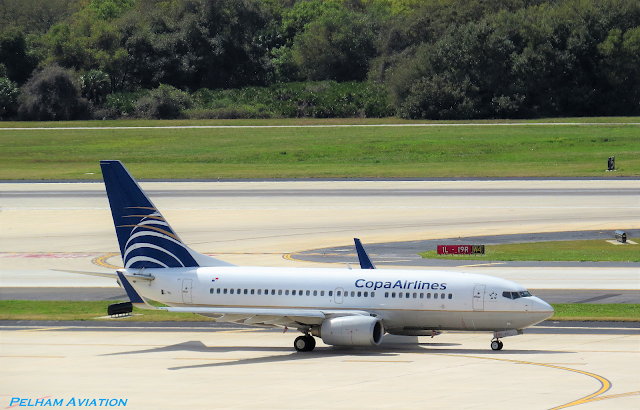Copa Airlines at Tampa International
CARRIER
ANALYSIS: Copa Airlines at Tampa International Airport
May
5, 2019
By:
Michael Gutta
With my first five blog reports I have reviewed
domestic airlines, routes, and fleet changes. For my first investigation of a
foreign air carrier, I have chosen to evaluate the service history of Copa
Airlines at Tampa International Airport. Copa Airlines is the flag carrier of
Panama, with a major connecting hub for Latin America at Tocumen International
in Panama City. Copa began service to Tampa International on December 16, 2013,
offering four flights weekly each way. For this blog report I decided to look
back at the USDOT data all the way back inaugural flight. Unfortunately, the
full-year of 2018 international flight numbers will not be published until June
13, so for now this study encompassed 4 years (2014-2017) of data, plus
December 2013.
 |
| Copa Airlines Boeing 737-700 registered as HP-1371 at Tampa International Airport (Michael Gutta). |
In the first 4 years of service by Copa at Tampa
International, there have been over 850 departing flights, with over 110,000 departing
seats, and nearly 80,000 departing passengers. The average load factor over the
4-year period was 72%, though it has been increasing in the last few years. Copa
Airlines has mostly maintained 4 times a week service from Panama City (PTY) to
Tampa International (TPA), except for a slight increase in the first full year
of service, 2014, at roughly 4.4 times a week service. This average value was, no-doubt, affected by
the daily service that was offered in December 2014. Below, the annual
departing statistics are shown, with a peak number of passengers and full-year
load factor in 2017, the most recent year of available data.
The chart above shows a low for passengers and
load factor in 2015, at just over 18 thousand departing passengers and an
average annual load factor of 65.7%. Fortunately, the number of departing
passengers increased 18,036 in 2015, to 18,705 in 2016, to 20,941 in 2017. This
passenger growth was achieved even with a flat number of departures. Accordingly,
the load factor increased from a low of 65.7% in 2015 to 72.9% in 2016 to a
full-year high of 78.5% in 2017.
In addition to the annual trends, I wanted to review
the seasonality of this route. Reviewing a month-by-month history only
confirmed that 2015 was quite grim, with May and September 2015 data showing a
load factor below 50%. December 2015, though, hit an annual peak of nearly 88%
monthly load factor. This large swing in monthly load factor indicates a strong
seasonality effect, though again this seems to have improved in recent years. The
plot below shows the monthly statistics for the last full year of data, 2017.
The 2017 monthly values seem to indicate that the
seasonality effect has improved, with the worst two months (April and October)
sporting load factors of right above 65%. Additionally, Copa posted the highest
monthly load factor from all 4 years of service for 7 of the 12 calendar months
in 2017. This feat alone is quite remarkable and shows that either the route
itself is strengthening, Copa is using more appropriately sized aircraft, or
Copa has adjusted seat prices based on the seasonal demand to fill aircraft
more efficiently.
 |
| Copa Airlines Boeing 737-700 taxiing during a busy day at Terminal F of Tampa International Airport (Michael Gutta). |
Moving forward, from the publication of this data
anyway, Copa and the Tampa International Airport have already announced that daily
service would begin on July 17, 2018. Additionally, Copa will continue to
evolve their fleet with the Boeing 737 Max aircraft, which has already made
appearances in Tampa. With the growing traffic statistics and the announcement
of daily flights, Copa Airlines at Tampa International seems to be in a good
place, pending any additional competition from Latin American airlines. This
seems unlikely in the near future at least. With Mexico City (MEX) being slot
constrained effectively eliminating Aeromexico or Volaris, the most likely
additional Latin airlines would be Avianca, Azul, Gol, or Latam. None of these
have quite the same North-to-South connectivity that Copa has at Panama City
(PTY) though.
Maybe more likely than additional Latin American
airlines serving Tampa International would be for Copa Airlines to begin
additional US service. The map above shows all US cities served by Copa in red,
with Tampa highlighted green, and all other US cities having service to Panama
City but not by Copa shown in black. Interestingly, Copa does not serve any
cities in the state of Texas, though airline partner United provides service
from Houston (IAH) to Panama City (PTY). Will Copa see a future service to the
large Southwestern cities of Dallas, Phoenix, San Antonio, or Austin soon?
 |
| Copa Airlines taking off from Tampa International Airport runway 19R (Michael Gutta). |
Let me know your thoughts on this blog post and
potential future topics involving the Tampa International Airport, Copa
Airlines, or really anything aviation related.
Data compiled for the report and figures above
came from the USDOT Bureau of Transportation Statistics T100 Tables. A few
other links to news stories are also shown below:
- https://www.transtats.bts.gov/Tables.asp?DB_ID=111
- http://www.tampaairport.com/media/press-releases/tampa-international-airport-and-copa-airlines-announce-nonstop-service-panama
- http://www.tampaairport.com/copa-airlines-expanding-daily-nonstop-service
- https://www.copaair.com/en/web/ar/new-route-panama-denver
- http://www.gcmap.com/mapui?P=PTY-BOS%2FORD%2FDEN%2FLAS%2FLAX%2FMIA%2FMSY%2FJFK%2FSFO%2FIAD%2FFLL%2Cc%3Agreen%2CPTY-TPA%2Cc%3Ablack%2CPTY-ATL%2FIAH%2FEWR&MS=wls&DU=mi





Comments
Post a Comment